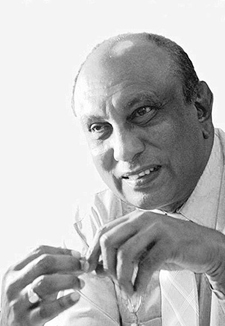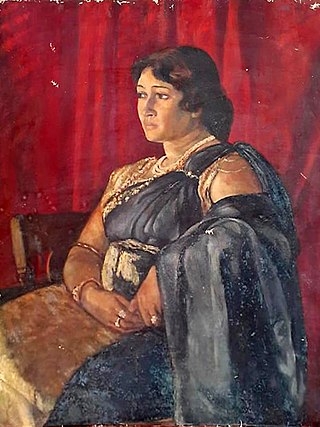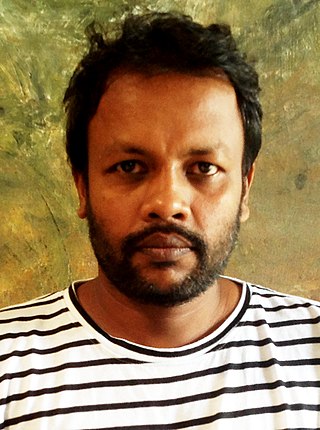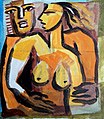George Percival Sproule Keyt, was a Sri Lankan painter. He is often considered Sri Lanka's most distinguished modern painter. Keyt's dominant style is influenced by cubism. He also claimed to be influenced by his contemporary Henri Matisse and the ancient Buddhist art and sculpture of Nagarjunakonda, Sanchi and Gandhara. The Jataka tales formed a recurring theme in many of his works.
Walter Kulasooriya is a Sri Lankan painter and former curator of the Visiki Art Gallery.

Deshabandu Tissa Ananda Abeysekara was a Sri Lankan filmmaker, actor, writer, director, screen playwright and political activist. He is better known as a script writer for the cinema as well as a film director. In 1996, his book Bringing Tony Home won the prestigious Gratiaen Prize for the new creative writing in English. He was the chief coordinator of FOSWAL in Sri Lanka and honoured awardee of SAARC Literary Award.
Sunil Das was an Indian expressionist painter. He is known for the paintings in his Bull Series and his piece "Woman".

Lionel George Henricus Wendt was a pianist, photographer, filmmaker and critic from Sri Lanka. He was the leader of ‘43 Group, a collective of Sri Lankan artists.
Ivan Peries was a founder member of the Colombo '43 Group of Sri Lankan artists, and became one of its leading painters. Born near Colombo, he spent more than half his life in self-imposed exile in London and Southend-On-Sea, but his art remained to the end a prolonged meditation on his native Sri Lankan experience.

Visakha Wijeyeratne was a Sri Lankan artist, painter, sculptor, writer and social worker. Her husband, Tissa Wijeyeratne, was a politician, diplomat, barrister and businessman.

Ananta Mandal is an Indian artist. He has been recognized with international and national honours for his watercolour, oil, and acrylic paintings. He lives and works in Mumbai, India.
Harold Peiris (1904–1981) was a Sri Lankan lawyer, author, scholar, teacher, patron of the arts, and philanthropist. He was the co-founder of the Lionel Wendt Art Centre and its sole life-trustee. He is sometimes confused with Harry Pieris, a cousin and contemporary, who was a member of the Colombo '43 Group of artists and established the Sapumal Foundation.
William Wright Beling was a talented Ceylonese watercolour painter of Dutch Burgher descent.
Jagath Weerasinghe is a Sri Lankan contemporary artist and archeologist.

Nawi Samaraweera is a Sri Lankan artist, born 26 July 1947 in Kamburupitiya, Matara.
William James Geoffrey Beling was a Sri Lankan artist, educator and one of the founding members of the Colombo '43 Group.
Anoma Wijewardene is a Sri Lankan contemporary artist. Wijewardene's paintings and installations reflect themes of sustainability, diversity and peace. She has held exhibitions around the world, including Venice, London, Sydney, Dubai, New Delhi, Hong Kong, Maldives and Colombo.
Anura Srinath is a Sri Lankan artist, painter, illustrator and cartoonist.

Charles Henry D. Freegrove Winzer (1886–1940) was a British painter and lithographer. He lived in Paris, and was interned by Germany in World War I. Afterwards, he worked in Sri Lanka, until retirement to Vienna. He is widely regarded as a leading light in the introduction of modern art to Sri Lanka.

Chamila Gamage is a Sri Lankan Contemporary Artist and Sculptor. His innate talent can be seen through number of different mediums including painting and drawing, sculpting and set designing. Chamila's styles are abstract art, modern art, expressionism art.

Cavaliere (OMRI) Tilake Abeysinghe, better known as Tilake, was an internationally reputed Sri Lankan painter and sculptor. Using traditional media such as oil on canvas and water colours, and sculpting in bronze, cement, clay and plaster-of-paris, Tilake fused oriental ethos with western sensuality in his art pieces. Tilake created abstract, semi-abstract and feminine form inspired paintings and sculptures.

Lady in Red is a half-length portrait painting done in 1928 by Sri Lankan artist Mudaliyar A. C. G. S. Amarasekara, that was accidentally discovered in the National Art Gallery in Cinnamon Gardens, Colombo, Sri Lanka.
Iromie Wijewardena is a Sri Lankan figurative expressionist artist. She has conducted many Sri Lankan local and international exhibitions since 1973.





























